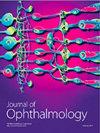Advanced Periocular Basal Cell Carcinoma with Orbital Invasion: Update on Management and Treatment Advances
IF 1.8
4区 医学
Q3 OPHTHALMOLOGY
引用次数: 0
Abstract
Purpose. Basal cell carcinoma (BCC) is the most frequent malignant periocular tumor. It is associated with exposure to ultraviolet radiation, and its incidence is gradually increasing. It may occasionally display more aggressive behavior and result in orbital or intracranial invasion. Mortality from periocular BBC with orbital invasion is very low, but the associated morbidity can be significant, from disfigurement to blindness. Traditionally, these cases have been treated with orbital exenteration or with radiotherapy (RT), but in recent years, hedgehog pathway inhibitors (HPIs) have emerged, are effective in more serious cases, and are used primarily or combined with surgery, changing our perspective on the management of these patients. Methods. We studied 24 cases of periocular BCC with orbital invasion, some primary and others recurrent, which were treated between 2011 and 2021 in the same hospital. All patients had clinical or radiological evidence of orbital invasion. Orbital exenteration was performed on 9/24 of the patients (1 received vismodegib after surgery), and 12/24 were treated, surgically preserving the eyeball, with 3 of them receiving adjuvant vismodegib. Three of the twenty-four patients were treated exclusively with vismodegib (Erivedge®, Genentech). Results. One patient died due to poor tumor evolution, but the rest evolved favorably and they have had no recurrences. Vismodegib was generally well tolerated, except for in one patient who discontinued treatment due to the side effects. Conclusions. In advanced BBC with orbital invasion, mutilating surgical treatments such as exenteration or potentially vision-threatening treatments such as RT remain as options. In recent years, however, very promising new medical therapies have emerged, such as HPI, which can be used effectively instead of surgery or in combination with it, preserving the eye and vision, which implies a new approach to treatment.侵犯眼眶的晚期眼周基底细胞癌:最新管理和治疗进展
目的:基底细胞癌(BCC)是最常见的眼周恶性肿瘤。基底细胞癌(BCC)是最常见的眼周恶性肿瘤。它与暴露于紫外线辐射有关,发病率逐渐上升。它偶尔会表现出更强的侵袭性,导致眼眶或颅内受侵。伴有眼眶侵犯的眼周 BBC 死亡率很低,但相关的发病率可能很高,从毁容到失明不等。传统上,这些病例采用眶外扩张术或放疗(RT)治疗,但近年来出现了刺猬通路抑制剂(HPIs),对更严重的病例有效,并主要用于或与手术联合使用,改变了我们对这些患者的治疗观点。方法。我们研究了 2011 年至 2021 年期间在同一家医院接受治疗的 24 例眼眶周围 BCC 患者,其中一些是原发性患者,另一些是复发性患者。所有患者均有眼眶受侵的临床或放射学证据。其中9/24的患者接受了眼眶外扩张术(1人术后接受了vismodegib治疗),12/24的患者接受了保留眼球的手术治疗,其中3人接受了vismodegib辅助治疗。24名患者中有3名只接受了vismodegib(Erivedge®,基因泰克公司)治疗。治疗结果一名患者因肿瘤进展缓慢而死亡,其余患者进展顺利,没有复发。除一名患者因副作用停止治疗外,其他患者对维莫代吉的耐受性普遍良好。结论对于有眼眶侵犯的晚期BBC,仍可选择损伤性手术治疗,如外翻或可能威胁视力的治疗,如RT。然而,近年来出现了非常有前途的新医学疗法,如 HPI,它可以有效地替代手术或与手术联合使用,从而保留眼球和视力,这意味着一种新的治疗方法。
本文章由计算机程序翻译,如有差异,请以英文原文为准。
求助全文
约1分钟内获得全文
求助全文
来源期刊

Journal of Ophthalmology
MEDICINE, RESEARCH & EXPERIMENTAL-OPHTHALMOLOGY
CiteScore
4.30
自引率
5.30%
发文量
194
审稿时长
6-12 weeks
期刊介绍:
Journal of Ophthalmology is a peer-reviewed, Open Access journal that publishes original research articles, review articles, and clinical studies related to the anatomy, physiology and diseases of the eye. Submissions should focus on new diagnostic and surgical techniques, instrument and therapy updates, as well as clinical trials and research findings.
 求助内容:
求助内容: 应助结果提醒方式:
应助结果提醒方式:


